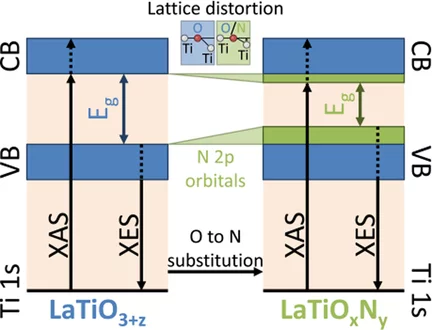The nitrogen substitution into the oxygen sites of several oxide materials leads to a reduction of the band gap to the visible-light energy range, which makes these oxynitride semiconductors potential photocatalysts for efficient solar water splitting. Oxynitrides typically show a different crystal structure compared to the pristine oxide material. As the band gap is correlated to both the chemical composition and the crystal structure, it is not trivial to distinguish which modifications of the electronic structure induced by the nitrogen substitution are related to compositional and/or structural effects. Here, X-ray emission and absorption spectroscopy are used to investigate the electronic structures of orthorhombic perovskite LaTiOxNy thin films in comparison with films of the pristine oxide LaTiOx with similar orthorhombic structure and cationic oxidation state. Experiment and theory show the expected upward shift in energy of the valence band maximum that reduces the band gap as a consequence of the nitrogen incorporation. This study also shows that the conduction band minimum, typically considered almost unaffected by nitrogen substitution, undergoes a significant downward shift in energy. For a rational design of oxynitride photocatalysts, the observed changes of both the unoccupied and occupied electronic states have to be taken into account to justify the total band-gap narrowing induced by the nitrogen incorporation.
Facility: Thin Films and Interfaces, LMX, SYN, EPFL, ETHZ
Reference: M. Pichler et al., ChemSusChem 10, 2099 (2017)
Read full article: here



